Building Public Support: Polling
The national strategy to win marriage – what Freedom to Marry called the Roadmap to Victory – said that we would win by persuading the Supreme Court to bring the country to national resolution, having built a critical mass of states and support, while overturning the federal so-called Defense of Marriage Act. To create the climate for that Supreme Court resolution, the Roadmap identified three intertwining tracks to victory: winning more states, ending federal marriage discrimination, and growing majority support. Much of Freedom to Marry’s public education, digital communication, and momentum-building work was dedicated to growing public support, thereby encouraging decision-makers, elected and judicial, to do the right thing.
Along with building, diversifying, and solidifying support for the freedom to marry, we also had to continuously educate the public, policy makers, and the national media that support was as high as it was – because the perception about public support tended to lag behind reality. We focused not just on “message,” but on message-delivery, working to generate millions of conversations, recruit and deploy diverse messengers, and ensure a drumbeat for the freedom to marry from reinforcing voices and media.
Polling on the freedom to marry improved sharply in the lead-up to the U.S. Supreme Court ruling, dramatically increasing from 27% support among the American people (at the time of the Hawaii trial in 1996) to 63% (in 2015).
Freedom to Marry devoted considerable expertise and resources behind-the-scenes to improving the movement’s capacity to engage public opinion research effectively. Specifically, Freedom to Marry:
- Tracked and amplified significant public support findings by major news and research organizations
- Provided movement partners, bloggers, and journalists with go-to sources for updated polling data, including sub-group measurements
- Established best practices for public support measurements and analysis among movement partners
- Commissioned original analysis and research, and persuaded movement colleagues to contribute their commissioned research and share in the analysis and propagation of the learnings
- Advised funders and movement partners on strategic implications of public support findings.
At key strategic points in the campaign, Freedom to Marry commissioned and released the following original research and analysis:
- Leading Republican and Democratic pollsters analyzed momentum for the freedom to marry in 2011 and again in 2013.
- Leading movement pollsters established a common set of viability benchmarks for state ballot measures in 2012
- A national survey of non-marriage states, released in January, 2014, which showed 51% support in aggregate in states without the freedom to marry, many of which were among the most conservative in the country.
- Additionally, Freedom to Marry either commissioned or coordinated original messaging research, addressed elsewhere.
SUMMARY OF PUBLIC SUPPORT TRAJECTORY
In 2010, both CNN (August) and the Associated Press (September) released the first national polls confirming that a majority of Americans had come to support the freedom to marry. Fifty-two percent of respondents told the AP that the government should recognize marriages between same-¬sex couples. The same percent had responded “yes” to the CNN question, “Do you think gays and lesbians should have a constitutional right to get married and have their marriage recognized by law as valid?" At the same time, research showed majority support in only 22 states. At the time, 22 was a good number, a sign of immense progress – but it also revealed the need to keep growing the majority in more communities and to ensure progress in every region.
In August, 2010, Nate Silver’s FiveThirtyEight.com released an analysis of marriage polls since 1988 that documented an accelerating shift in support for the freedom to marry. Silver’s analysis showed a 4-point gain in support of marriage for same-sex couples in 16 months from 2009-2010. In the past, support for marriage had grown at a rate of 1 to 1.5 points per year. Internally, Freedom to Marry had targeted increasing support by 2 percentage points per year. Once momentum took off, the pace documented by FiveThirtyEight accelerated even further. A 2015 analysis by the Williams Institute found that support for marriage, beginning in 2012, grew at a remarkable 6.2% per year.
Back in 2010, along with trumpeting the historic milestone of having crossed the 50% threshold, Freedom to Marry also emphasized some of the subgroup findings that foretold the change the nation was undergoing, such as the higher levels of support among young people. We scrutinized research by organizations such as Gallup, AP, CNN, The New York Times/CBS, Washington Post/ABC, Wall Street Journal/NBC, Time, Pew, Public Religion Research Institute, Quinnipiac University, and Public Policy Polling. We used a variety of media (fact sheets, blog posts, news releases, public presentations, etc.) to showcase and tout growing support as new research documented increases among African Americans, Latinos, Republicans/ Conservatives, Catholics, and even Evangelicals. We always believed that highlighting support and progress helped increase momentum and bring along others.
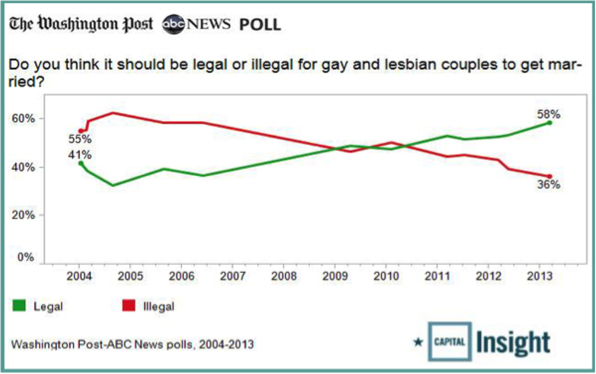
Support for the freedom to marry grew rapidly from 2004-2013.
By 2013 the trajectory was clearly established and we frequently pointed to this graphic depiction of the change in American opinion illustrated by the WaPo/ABC annual findings over the course of a decade.
We knew that support was concentrated in so-called “blue” states, states where the freedom to marry was in several cases the law of the land. As we began making the case that all of America was ready for the freedom to marry, we commissioned a confidential study of then 34 non-marriage states (in late 2013). Upon finding that support in those states was at 51%, we released the poll publicly (see below for detail). A complementary piece of research was conducted by the Williams Institute in 2015 that once a state gained the freedom to marry, support for marriage between same-sex couples does not just continue to grow, but accelerates. We used this proof point to help drive home the narrative that “America is ready for the freedom to marry,” and that if the Supreme Court now did what we were asking and brought the country to national resolution, support would only grow.
By February, 2015 – in the months when the Supreme Court was considering the case that would ultimately deliver our final victory – a CNN/ORC poll showed the highest percentage of Americans ever, a 63% supermajority, backing the freedom to marry as a constitutional right for gay couples. This reflected a 14-percentage point gain from 2010, with significant increases by both Republicans and Democrats. Three other polls on marriage in 2015 tracked support at 60% or higher.
In this video from FiveThirtyEight.com Thalia Zepatos tells the story of how polling data helped us win.
ORIGINAL RESEARCH & ANALYSIS: JOINT POLLSTER MEMOS
In 2011 Freedom to Marry contracted with President George W. Bush’s pollster, Dr. Jan van Lohuizen, and President Obama’s pollster, Joel Benenson, to conduct a joint meta-analysis of public opinion on the freedom to marry. We released the resulting memo at a widely covered event featuring them and Freedom to Marry founder Evan Wolfson at the National Press Club on July 27, 2011.
Their analysis of polling data spanning more than a decade regarding public attitudes on the freedom to marry showed steady growth in support over a 13-year period, with a striking and undeniable acceleration over the past two years. They stated that the surge was the result of much more than changing demographics. It was actually the evolving positions among every group analyzed, including older Americans and Republicans, groups that had been the least supportive of the freedom to marry.
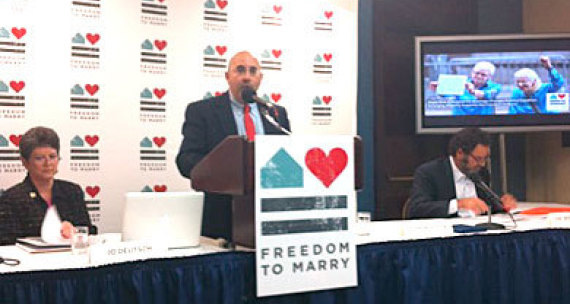
Evan Wolfson at the National Press Club in 2011, discussing polling trends with pollsters Joel Benenson and Jan van Lohuizen.
Freedom to Marry went back to the bipartisan pair again in 2013 for an update. The headline of the March 2013 report read: Publicly released polling since November 2012 shows that a broader, more diverse majority of Americans support the freedom to marry, while opposition is increasingly isolated within narrow demographic groups.
ORIGINAL RESEARCH & ANALYSIS: PUBLIC SUPPORT BENCHMARKS FOR BALLOT MEASURES
Following the defeats at the ballot in California (2008) and Maine (2009), some movement leaders and funders believed that it was too risky to try to win marriage via ballot measure. Others believed that ballot measure wins resulting from strategically targeted viable states would be critical to signaling the Supreme Court that America was ready—and practically speaking, represented the only pathway forward in states that were increasingly ripe. Heading into 2012 there were several states Freedom to Marry considered potentially viable at the ballot.
An operating assumption of that time was that, on marriage, we would only lose, not gain, support during a campaign. Thus certain funders and others suggested that the public support numbers would have to be high enough, e.g. 60%+ even prior to a campaign, to ensure victory – and these numbers didn’t exist in any prospective state at that time. The argument was that we should engage in public education and wait for demographic shifts in the voting population and continued movement among the public to get to the 60 percent threshold prior to affirmatively going to the ballot. We did not believe this conventional wisdom was correct, and had to figure out how to persuade our partners, including key funders, to invest in the work to win in 2012.
To build confidence, and challenge all of us to ramp up our work, Freedom to Marry brought together national partners and funders to develop a set of ballot-measure readiness benchmarks that included public support numbers. We asked three leading research firms working on the issue – Amy Simon of Goodwin Simon Strategic Research, Lisa Grove of Grove Insight, and Donna Victoria of Victoria Research & Consulting – to work together on a set of advisory guidelines.
Based on consultation with these and other researchers, Freedom to Marry circulated a confidential memo among partners and funders that asserted:
"The 60% threshold for advancing a ballot measure does not apply to issues as thoroughly vetted as the freedom to marry. The justification for such a high threshold is that issues can and often do lose ten percent or more in the polls once opponents of the measure begin challenging and poking holes in it. This question is different, however. Americans have been discussing and debating marriage for gay couples for years; they are very familiar with the arguments pro and con; and have personal understanding of marriage and, increasingly, of gay and lesbian couples. As a result, the so-called moveable middle on this issue is as small as 5 to 15 percent, and as a result, shifts during a campaign are relatively low. This is corroborated in the 2010 analysis by NYU Professor of Political Science Patrick Egan, PhD entitled Findings from a Decade of Polling on Ballot Measures Regarding the Legal Status of Same Sex Couples. In his analysis of previous referenda on marriage, Egan finds that “those favoring and opposing the ballot measures have largely fought to a draw, in that the share of the public saying they intend to vote for or against these measures typically changes very little over the course of these campaigns. [Egan’s analysis is of anti-marriage ballot initiatives. Thus, it may not be fully applicable to proactive initiatives.] Other research, including the comprehensive analysis of the Let California Ring public education effort, demonstrates that opinion can be moved through a thorough public education campaign in advance of a ballot fight, prior to the intensive back and forth of the political phase when people tend to disengage on an issue that they feel they know."
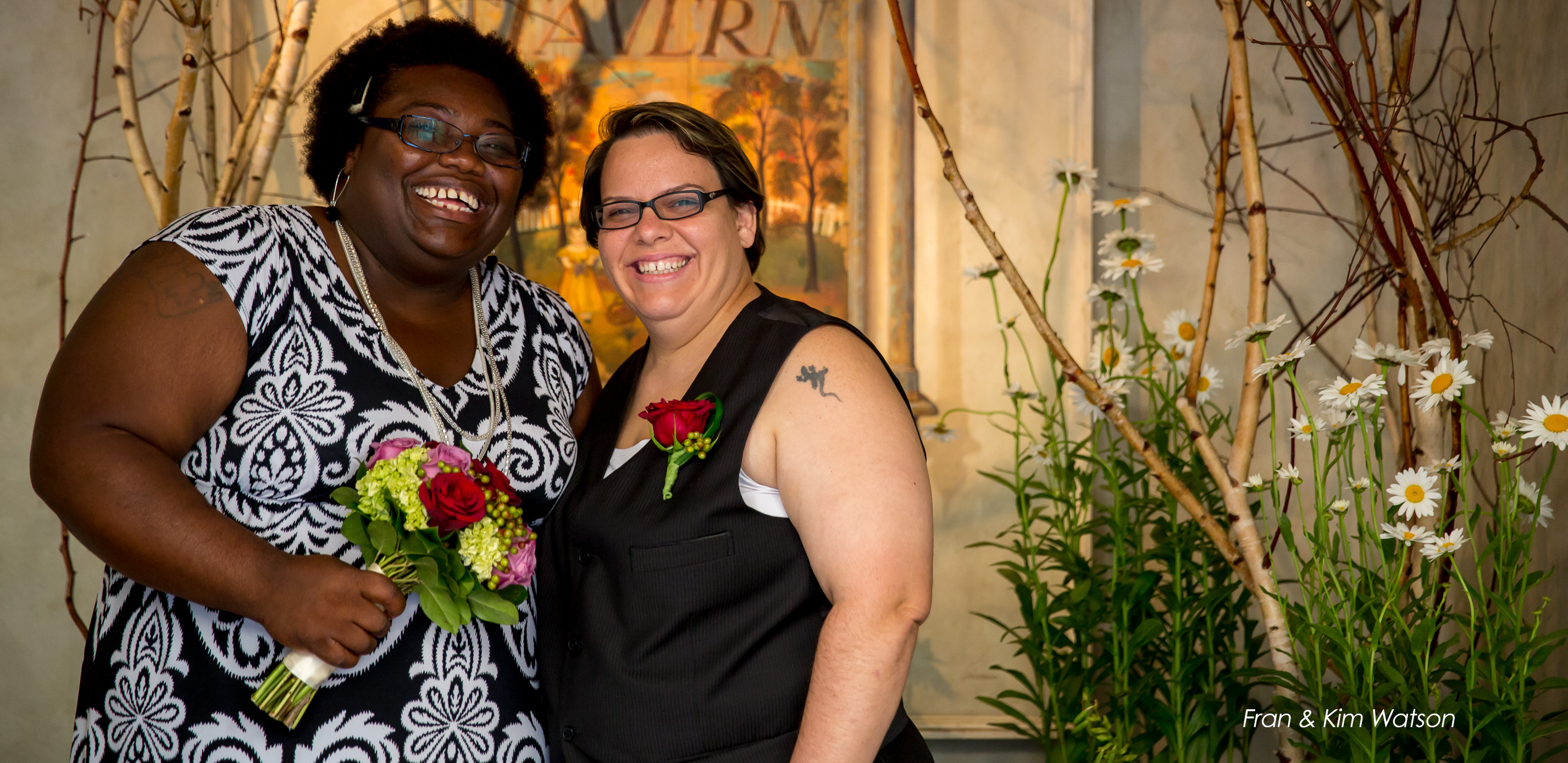
ORIGINAL RESEARCH & ANALYSIS: SUPPORT IN NON-MARRIAGE STATES
By mid-2013 when our movement had won the freedom to marry in more than a dozen states through a mix of ballot measure, legislative, and court victories, the map showed our enormous project, and, also, a divided America. We believed it would be important to the climate for an eventual Supreme Court decision to reveal more about attitudes in those states without the freedom to marry that were typically submerged in the national support numbers. We wanted to make the strongest case possible and show that we had achieved what our Roadmap to Victory national stategy called for: a critical mass of states as well as support. To be able to address where we hadn’t yet won, we contracted with Anzalone Liszt Grove Research to do a poll of the 34 states without marriage for same-sex couples.
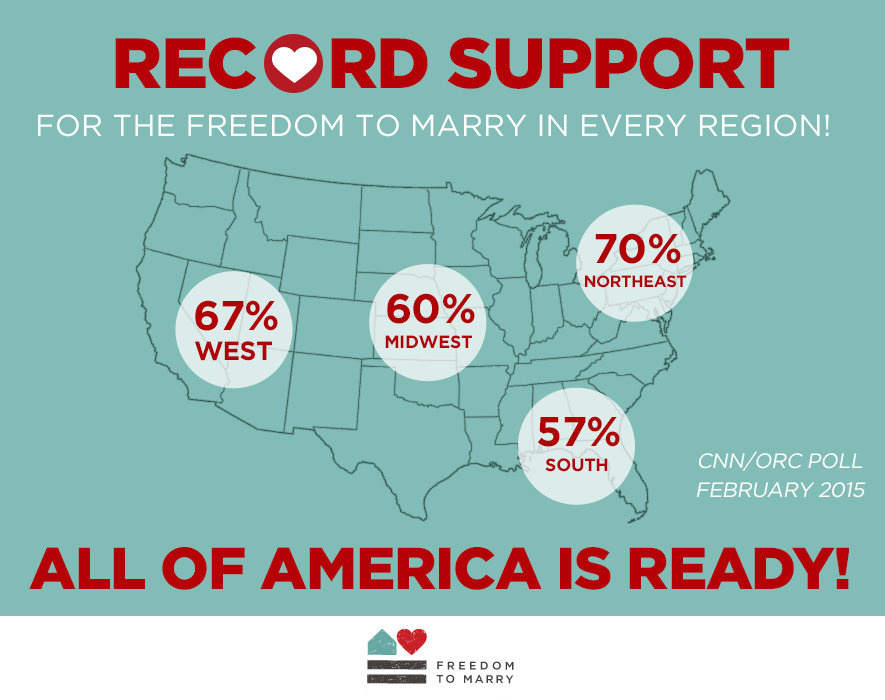
Importantly, the poll demonstrated majority support even in these states, with 51% of respondents saying they supported marriage for same-sex couples, and only 41% saying they were opposed. We shared these compelling results widely, generating significant news coverage. Key findings included:
- In every region of the country, voters support the freedom to marry: In Central states, 59% of respondents supported marriage for same-sex couples (with just 36% opposed, a 23-point margin). In Western states, 53% were supportive (with 34% opposed, a 19-point margin). And even in the South, Freedom to Marry became the first to report that voters were split evenly, with 46% in favor and 46% opposed.
- 78% of respondents said that they believe extending the freedom to marry to same-sex couples would either have a minimal impact or positive impact on them personally. Just 21% believed that marriage between same-sex couples would have a negative impact.
- Regardless of their personal views on marriage, voters in non-marriage states feel that same-sex couples will have the freedom to marry in their state in the next few years. A majority (56%) said they believe this, and even among opponents of the freedom to marry, 49% said they believe their state will be marrying same-sex couples soon.
BEST PRACTICES FOR PUBLIC SUPPORT MEASUREMENTS & ANALYSIS AMONG MOVEMENT PARTNERS
In addition to publicly released research and analysis, Freedom to Marry devoted considerable time behind the scenes working with state and national movement partners to develop best practices for the research in this field as the Marriage Research Consortium. Some of this work is described in The Marriage Movement's Secret Weapon: Radical Cooperation. Much of the best-practices work took place in consultation with individual state campaigns where Freedom to Marry director of research & messaging Thalia Zepatos worked closely with campaign research teams to determine their research strategy, vet polling questions, and analyze results. We conveyed best practices through national conference calls where results of internal research were shared with movement partners and funders, helping to foster a collective understanding of and commitment to the research norms that were proving most effective.
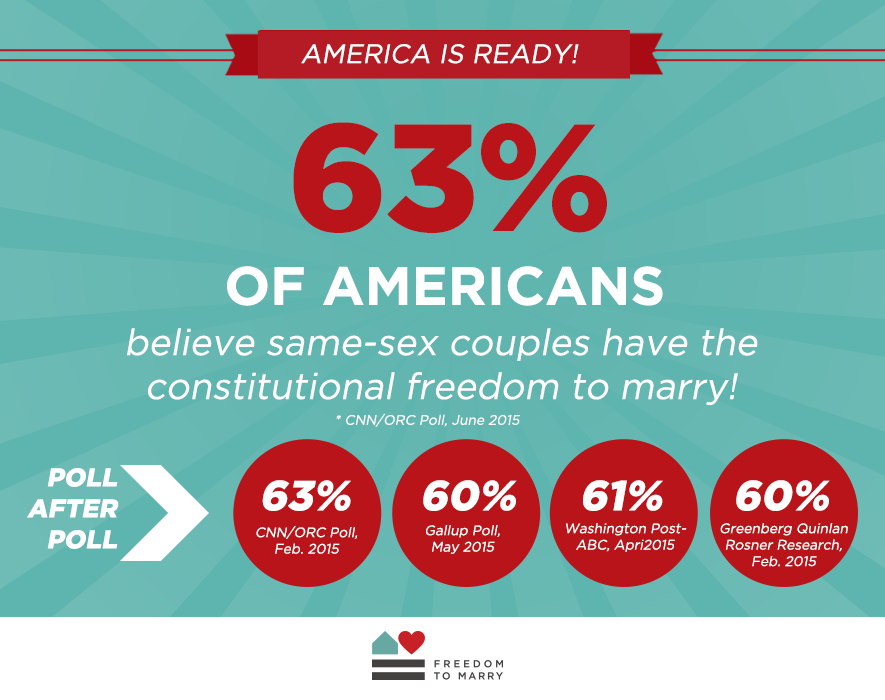
These best practices included:
- Determining the best language to use for marriage polling (for internal and external use) and promoting consistent use of that language with all partners. Our analysis found that different wording could produce significant variations in results; we worked to identify the language that produced the most consistent and reliable results.
- Paying careful attention to language used by major polling organizations, e.g. Gallup, to glean insights and determine language to test internally.
- Discovering a reliable way to differentiate our core support from undecided or conflicted voters who might otherwise be labeled as supporters via what we came to call the three-way question: Which best describes your view: gays and lesbians should have same opportunity to marry as other couples; should have access to domestic partnership or civil unions but don’t need marriage; should have no legal rights or recognition. Some of those who found domestic partnership or civil union acceptable would answer that they supported marriage if the options were only marriage or nothing. This three-way question gave us an understanding of the numbers and characteristics of those soft supporters who were vulnerable to slipping away if another option were presented.
- Using consistent questions from one poll to another – not just within a given campaign or state but when possible across different research projects sponsored by different partners. [Note: this was greatly facilitated by the structure, relationships, and resulting trust built through the Marriage Research Consortium organized by Freedom to Marry, and was supported by movement funders through the Civil Marriage Collaborative]
- Requiring partnering states and campaigns in which Freedom to Marry had invested to use consistent language and share their results across organizations; and sharing original research we conducted with other partners.
Key Lessons Learned
- We developed a cohort of several different pollsters to use across multiple projects, gaining the value of consistency while not getting locked into a single line of thinking with a single team. Each was hired with the expectation of collaborating with their competitors; thus they were able to check and validate each other’s work and work together when needed on special projects.
- We boosted our national profile and reputation at key points by hiring a bipartisan team of leading pollsters to provide independent analysis and opinion, which proved very helpful in making the case to national media and key political strategists, pundits and elected officials.
- We constantly reviewed the research for new findings that reflected shifts in individual demographic groups, publicizing new insights that helped us make our case.
- We helped researchers and reporters dig deeper to reveal insights that challenged conventional wisdom; for example, emphasizing levels of support and acceleration of that support among communities of color and clarifying that religiosity and not race was the determining factor in African American support levels.
- Freedom to Marry’s website became the go-to resource for the status of polling on the question.
- We used every megaphone possible to publicize the increases in public support – from blog posts and news releases to demographically specific fact sheets and targeted briefing materials.